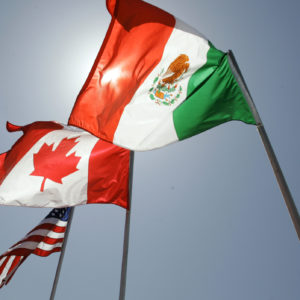Editor’s Note: For an alternative viewpoint, please see: Counterpoint: Here’s What a Better NAFTA Looks Like
The fourth round of talks aimed at revamping the North American Free Trade Agreement ended this week in Washington, with Canada and Mexico rejecting a variety of U.S. proposals. The negotiators will be back at the table next month in Mexico City.
The trilateral trade pact has always had its critics. When it went to Congress for approval in 1993, the opposition’s claims were so over the top, they were brutally lampooned in one of “Saturday Night Live’s” classic fake advertisements.
The ad, “Paid for by United We Stand American and the AFL-CIO,” featured Rob Schneider as a “stereotypical Mexican.” He explained the trade deal this way: “It is very simple. This pinata represents the United States economy. And this bat represents NAFTA. Watch what NAFTA does.”
After smashing the U.S. economy with the NAFTA bat, Senor Schneider concluded: “You see? All the goodies fall down south, to Mexico.”
Fortunately, Congress did not fall for the arguments pushed by NAFTA’s critics. NAFTA has proved to be a tremendous success for Canada, Mexico and the United States.
In 1994, critics said the United States would lose jobs. But the average U.S. unemployment rate has been lower in the 23 years since NAFTA took effect than in the 23 years prior to the pact. Post-NAFTA, our economy has added, on average, more than a million jobs annually.
Critics said U.S. manufacturing would suffer. Instead, manufacturing output increased by 80 percent. According to the Bureau of Labor Statistics, average hourly compensation for manufacturing workers increased from $20.72 in 1994 to nearly $40 today.
Critics said there would be a flood of companies leaving the United States to invest in low-wage Mexico. Instead, since 1994 the United States has attracted nearly $4.5 trillion in foreign direct investment from abroad. The United States remains the world’s most powerful magnet for foreign investment dollars.
The beneficial impact of NAFTA is not remotely controversial among economists who have studied the effect of the agreement. A 2012 survey conducted by the University of Chicago’s Initiative on Global Markets found that more than four of every five economists agreed that “on average, citizens of the U.S. have been better off with the North American Free Trade Agreement than they would have been if the trade rules for the U.S., Canada and Mexico prior to NAFTA had remained in place.”
NAFTA was a true “win-win-win” agreement, and all three countries have much stronger economies now than they did before NAFTA took effect.
Other countries have attempted to replicate NAFTA’s benefits. Since 1994, foreign nations have entered more than 250 agreements liberalizing trade. The most recent is the Comprehensive Economic and Trade Agreement between Canada and the European Union. It eliminates 98 percent of the tariffs between Canada and the member nations of the European Union.
Given the advantages America has gained under NAFTA and the free-trade advances other nations have made since 1994, it would be a big mistake to toss NAFTA and “turn back the clock” to 1993. But there are certainly some areas where the agreement could be improved.
NAFTA was accompanied by side deals on environmental and labor policies. Canadian negotiators have demanded that the United States abolish state “right to work” laws. And there have even been proposals to add gender equality requirements to a new NAFTA agreement.
Trade deals should stick to trade matters. Issues — old and new — that aren’t directly related to trade should be dealt with separately.
One way to improve NAFTA would to target it to areas directly related to international commerce, while resisting calls to impose new international environmental and labor regulations through the back door of a trade agreement.
Another possible improvement would be to make it harder for Canada and Mexico to tax competitive U.S. exports through their use of protectionist “anti-dumping” policies. Canada and Mexico have used these laws to restrict U.S. exports of products ranging from potatoes to steel. A true “free trade” agreement should give Americans full access to customers in Canada and Mexico.
NAFTA can also be updated to incorporate digital trade issues, which were not relevant back in 1994. For example, Americans should be able to make full use of trading platforms from eBay, Amazon, Google and other companies without interference from government-erected barriers.
NAFTA’s model of economic freedom has been widely emulated by other countries. Instead of scrapping the pact, we should build on its success by negotiating an even better win-win-win deal for all three countries.

